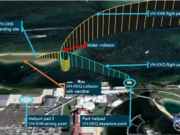
Regulatory authorities should alter the certification requirements for light helicopter designs to reduce the risk of accidents involving loss of main rotor control, the U.K. Air Accidents Investigation Branch (AAIB) says.
The AAIB included its recommendations to the European Aviation Safety Agency (EASA) and the U.S. Federal Aviation Administration (FAA) in its final report on the Jan. 6, 2012, crash of a Robinson R22 Beta near Ely, Cambridgeshire, England.
The accident killed the 50-year-old pilot — a flight instructor in airplanes with nearly 5,000 flight hours who was trying to increase his 58 hours in helicopters so that he could earn a commercial helicopter license and a license to instruct in helicopters. The helicopter was destroyed.
The AAIB report said the cause of the accident was “main rotor divergence resulting in mast bumping” — a condition in which the main rotor hub contacts the main rotor mast. As the rotor blades continue to “flap,” each contact becomes more violent, and the result can be damage to the rotor mast or separation of the main rotor system from the helicopter.
The accident flight began at 0958 local time, when the helicopter left Manston Airport for a flight to Fenland Airfield, about 240 km (130 nm) northwest.
The pilot told air traffic control, as the R22 passed east of Cambridge Airport at 1118, that the helicopter was flying at 1,400 ft. That was the last radio transmission received from the pilot. The helicopter continued northwest, toward Fenland, and disappeared from radar about 1125.
Witnesses on the ground southwest of the accident site said they saw the helicopter rapidly pitch and roll left and heard a “pop, as if it was a paper bag you banged in your hands,” the report said. Two witnesses also said that they saw objects separate from the helicopter before it fell, inverted, to the ground.
The wreckage was found in a field 2 nm (4 km) southwest of Ely. The helicopter was inverted and there were few ground marks, indicating that the helicopter had little horizontal speed just before the impact. Both main rotor blades had separated from the hub and were found several hundred meters from the main wreckage. One tail rotor blade also had separated and was not found, but the other was still attached. There was no indication that the main rotor had struck the tail boom, the accident report said, noting that “tail boom separation following main rotor contact has been a characteristic of a number of R22 in-flight structural failures.”
Accident investigators said that weather conditions at the time of the accident included visibility of 30 km (19 mi), few clouds below 25,000 ft and a light, westerly wind that was not considered strong enough to have generated low-level turbulence. They said either wake turbulence or a need for a sudden maneuver to avoid another aircraft was highly unlikely.
Robinson R22
The Robinson R22 is a light, two-seat helicopter first flown in 1975. The R22 Beta was certificated in 1985.
It has a two-blade main rotor with a tri-hinged underslung rotor head designed to limit blade flexing and rotor vibration, and a two-blade tail rotor.
The R22 has one 119-kw (160-hp) Textron Lycoming O-320-B2C piston engine, and a 72.5 L (19.2 gal) fuel tank. The empty weight is 374 kg (824 lb), and maximum takeoff and landing weight is 621 kg (1,370 lb).
Maximum rate of climb at sea level is 1,200 fpm; maximum level speed is 97 kt; and range at sea level with auxiliary fuel, maximum payload and no fuel reserves is 592 km (319 nm).
Source: Jane’s All the World’s Aircraft, U.K. Air Accidents Investigation Branch Report EW/C2012/01/01
The accident helicopter was manufactured in 1988; at the time of the accident, the airframe had been in operation for 6,407 hours and the engine, for 1,595 hours. The last maintenance check was a 50-hour check completed Dec. 6, 2011 — 28 flight hours before the accident. No significant defects were found, the report said.
Maintenance records included no mention of any disturbance of the pitch control links during the year before the accident and showed that the last “known disturbance” of the rotor system occurred in April 2010, when the main rotor blades were removed for replacement of the spindle bearings.
Examination of the wreckage found damage to the main rotor that showed that the main rotor blades had “flapped to extreme up and down angles prior to separation,” the accident report said.
This condition — known as main rotor divergence — has several causes in helicopters such as R22s, which have “teetering, two-bladed rotors,” the report said, citing low-g maneuvers, low-rotor rpm, turbulence and “large abrupt control inputs.”
The report said it was “possible that a combination of low rpm, an abrupt control input and low-g caused the main rotor divergence. … If carburetor ice caused a loss of rotor rpm, this would have triggered the low rpm audio warning, and this warning sounds like the stall warning in some light fixed-wing aircraft. The response of a fixed-wing pilot to a stall warning is often to push forward on the controls to un-stall the wing. This would be an inappropriate response from the pilot in these circumstances but understandable given that the vast majority of his flying was in fixed-wing aircraft.”
The report said that low rotor rpm “could explain why the pitch link failed in the way that was observed” — with the separation of the no. 1 pitch link and indications that the attached bolts had failed because of overload resulting from the application of considerable force.
In addition, the report said, “the forward deflection of the cyclic, leading to a low-g flight condition, could explain the rapid roll, but only if the witnesses were mistaken and the roll was, in fact, to the right.”
The report also cited previous studies, including a 1996 study by the U.S. National Transportation Safety Board (NTSB), that linked “large, abrupt control inputs” to mast bumping.1
NTSB Study
The report noted the NTSB’s 1996 recommendation calling on the FAA to require helicopter manufacturers to “provide data on the response of helicopters to large, abrupt cyclic inputs as a part of the certification process.”
The FAA implemented part of the recommendation by modifying Advisory Circular (AC) 27.661, Rotorblade Clearance, to require manufacturers to conduct a blade flapping survey.
“However, the AC did not define what the control deflections should be or what the rate of input should be,” the AAIB report said. “It specified that margins should be determined, but it did not specify what the margins should be.”
The NTSB eventually closed out the recommendation and characterized the FAA’s response as “acceptable,” but the AAIB said that the NTSB action was influenced by the decline in the number of accidents involving main rotor loss of control in the mid-1990s.
“The NTSB attributed this to the increased training and experience requirements imposed by the FAA,” the report said. “However, since the 1996 NTSB study, there have been at least a further 16 fatal R22 accidents involving loss of main rotor control.”
Precise causes of many of these accidents have been difficult to determine, the report said, “because the pilot’s control inputs leading up to the divergence are rarely known.”
Nevertheless, the report added that some of the 16 accidents probably resulted from a loss of rotor rpm that followed a power loss “without the pilot lowering the collective quickly enough. In the R22, the pilot must react to a loss of power by lowering the collective in less than about 1.5 seconds in the cruise, or one second in the climb, to prevent rotor stall.”
As a result, EASA has begun a study of the effect of increasing the required reaction times, the report said.
Handling Qualities
The report said that handling qualities are another probable factor in a number of R22 crashes involving loss of main rotor control.
“Only light control forces are required to apply full cyclic deflection in the R22, making it easy inadvertently to enter a low-g situation or to make an abrupt and rapid control input leading to rotor stall and mast bumping,” the report said.
FAA and EASA certification requirements, which have changed little in recent decades, are less stringent than equivalent military requirements, the report said.
The document noted that a 2005 study by the U.S. National Aeronautics and Space Administration Ames Research Center included a recommendation calling on helicopter manufacturers to “explore the feasibility of designing a low-cost, lightweight stability augmentation system, which would also provide benefits for the reduction of low-speed and hovering helicopter accidents.”
In addition, the AAIB report said that a stability augmentation system “would provide some control force feedback, thereby making large abrupt cyclic inputs less likely, as well as recovering the aircraft to a safe attitude should the pilot release the cyclic control.”
Safety Notices
Robinson Helicopters included a series of safety notices in the R22 Pilot’s Operating Handbook that discussed, among other topics, the dangers of failing to maintain rotor rpm and the importance of avoiding a rotor rpm stall.
“As the rpm of the rotor gets lower, the angle-of-attack of the rotor blades must be higher to generate the lift required to support the weight of the helicopter,” one safety notice says. “As with the aeroplane wing, the blade aerofoil will stall at a critical angle, resulting in a sudden loss of lift and a large increase in drag. The increased drag on the blade acts like a huge rotor brake, causing the rotor rpm to rapidly decrease, further increasing the rotor stall.”
The AAIB report noted that in an airplane, a pilot would react to a stall warning horn by moving the control column forward to reduce the wings’ angle-of-attack and adding power. A similar response in a helicopter, however, can result in the low-g condition associated with an uncontrollable right roll and mast-bumping.
Lightweight Data Recorders
The report noted that Robinson Helicopters has agreed that additional information is needed “to fully understand the causes of accidents involving main rotor divergence.” The company was considering the installation of a small lightweight flight data recorder in its aircraft to help provide more data on pilot control inputs in the moments preceding a main rotor divergence, the report said.
“The pilot’s control inputs leading up to the divergence are rarely known,” the report said. “If the helicopter manufacturer succeeds in developing a lightweight flight data recorder for the R22 that includes recordings of control positions, it is likely that there will be new insights into the causes of main rotor divergence.
“The technology already exists to create a small lightweight recorder that includes solid-state three-axis gyros, three-axis accelerometers, GPS [global positioning system] and an altitude pressure sensor, but one of the challenges is to develop a lightweight and non-invasive means of measuring control positions.”
The company also plans research on the likely effectiveness of combating carburetor icing by installing a heated throttle butterfly in the carburetor, the report said.
Other design solutions also could help reduce the potential for accidents involving loss of main rotor control, the report said.
“Therefore, the certification requirements for future helicopter designs should be updated and improved to reduce the risk of loss of control and loss of main rotor control accidents,” the report added. “It is desirable that the EASA and FAA cooperate in this task.”
This article is based on AAIB Accident Report No. EW/C2012/01/01, published in the February 2013 “AAIB Bulletin.”
Note
- NTSB. Special Investigation Report — Robinson Helicopter Company R22 Loss of Main Rotor Control Accidents, NTSB/SIR-96/03. 1996.


